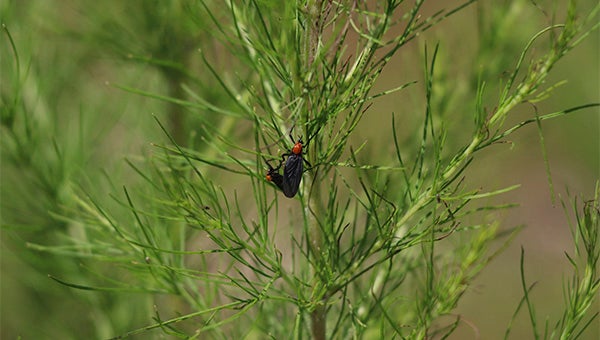Lovebugs? Hatebugs!
Published 7:00 am Wednesday, September 14, 2016

LIFE AND DEATH: Lovebugs, doing what adult lovebugs do when they’re not flying into the path of traffic, frolicking in the outdoors.
Photo by Jeremy Pittari
By JoAnne Norton
Pity the lovebug, the twice-a-year bane of car owners along the Gulf Coast. They don’t sting, they don’t bite, but such a sweet name belies its sour effect on car finishes and drivers’ patience.
The lovebug, known scientifically as Plecia nearctica and also by such romantic monikers as the kissingbug or honeymoon fly, usually takes to the air in Mississippi in May and again in September, when the generation born the season before matures and starts the cycle again, according to entomologists at two state universities.
Trending
The lovey-dovey nicknames come from their brief adult appearance: an insect couple, joined at the abdomen, reddish-orange thoraxes apart, bumbling through the air or along the ground, and splatting in untold numbers onto windshields, bumpers and hoods.
“The adults are the ones we most often interact with when we’re walking or driving,” said Donald Yee, an entomologist in the Department of Biological Sciences at the University of Southern Mississippi.
The adults live just long enough to mate, securing the next generation, or die trying. Most of the lovebug’s life is spent where people don’t often look: between blades of grass.
“The larva occupy the sort of turf-thatch area in grassy lawns,” Yee said. “That’s where the larva actually live, and they’re consuming that thatch, so they’re providing a role as a decomposer.”
The human passion for a manicured lawn gives the larval lovebugs plenty to chew on, Yee said.
“We can kind of partly attribute lovebug population sizes to the fact that we like to maintain lawns,” he said.
Trending
The size of the seasonal brood varies depending on the weather, he noted. “We have had a relatively wet year,” Yee said. “That’s going to promote larger populations.”
Adult lovebugs can fall prey to dragonflies and other insects, spiders, and frogs, in addition to oncoming traffic, Yee said.
Business is brisk in the car-cleaning solution aisle at O’Reilly’s Auto Parts in Picayune, according to store manager Chuck Bowers, who recommends investing in deflectors.
“People need to be reminded to get them off their cars,” said John Guyton, an entomologist with Mississippi State University Extension Service. “They need to keep a scrub brush nearby. If they make a long daily trip, like up and down I-10, they ought to get the brush wet and scrub.”
That’s because the lovebugs’ innards are acidic.
“They will erode the car finish a little bit,” Guyton said. “It will take the wax off and start attacking the paint.”
He also cautioned drivers to keep what’s behind the grille of the car clean of bug debris.
“Check your radiators periodically; the car could overheat,” he said.
“Whatever you do, don’t leave buckets of water around; that helps the mosquitos, something we also don’t need more of,” said Guyton, who’s talking about bugs with the public this weekend at Crosby Arboretum.
Unlike mosquitos, though, lovebugs are relative newcomers to southern Mississippi. Entomologists said the bugs, native to Central America, were first spotted in Louisiana in the early 20th century and migrated east, arriving in Florida by about mid-century. By the turn of the millennium, they had bumbled north as far as North Carolina.
That fast spread has given rise to urban legends about the lovebug’s origins, including a tale that they’re the product of some kind of mad scientist’s project. Real scientists scoff at such talk.
“They’re kind of new here, relatively speaking, because they’re not a native species,” Guyton said. “We kind of wish they’d not come for a visit, and certainly wish they’d not come and stayed.”





